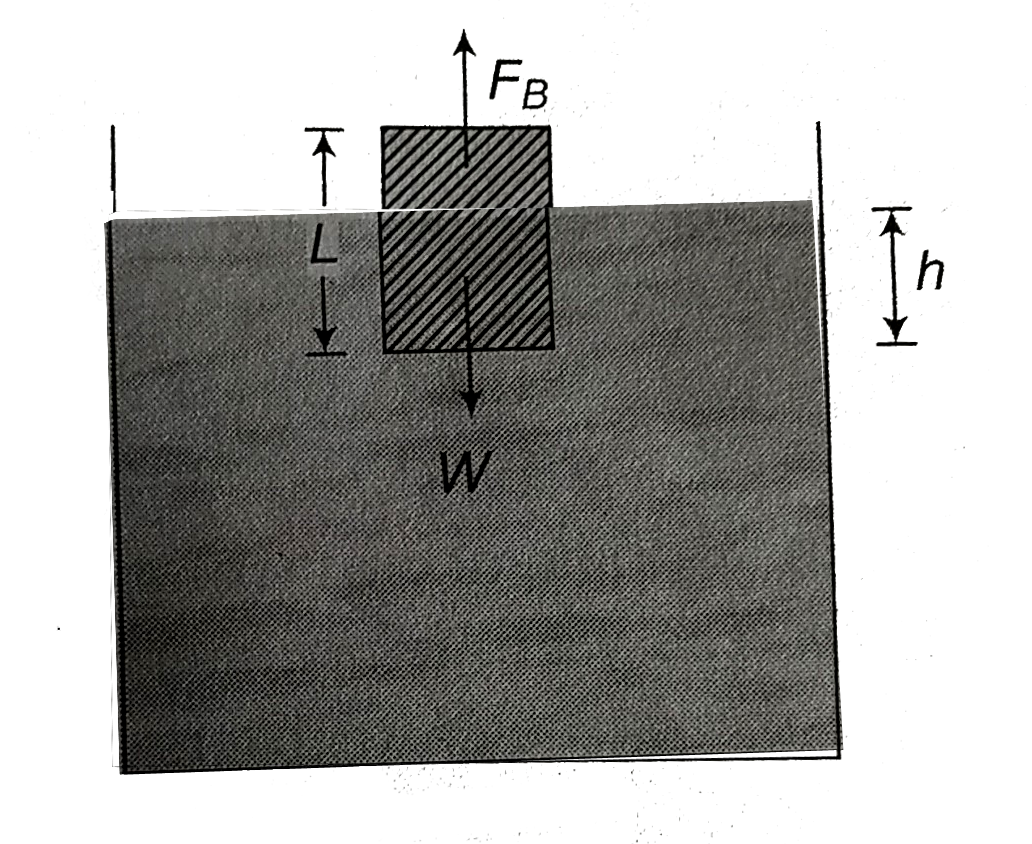An aluminium cube of side 20cm floats in mercury. How much farther will the block sink when tempereture rises from 27∘C to 77∘C ? Density of aluminium and mercury at 27∘C are 2.7 and 13.6g/ while the coeficient of volume expansion of mercury and linear expansion of aluminium are 1.8×10−4/∘C and 23×10−6/∘C respectively.
In case of floatation
Weight=Upthrust
W=Fb
σVg=pV'g
σV=pV'
σ : density of material of block
p : density of liquid
V , volume of block
V' : immersed volume of block
σV=pV'
σL3=pL2h
h=σpL=2.7×2013.6=3.97cm
L : side of cube, h : length of cube immersed in liquid As weight of block remains same σVg=p27V'27g=p27V'77g
p27L2h=p77L'2h'
L'=L(1+αsΔθ),p77=p271+γmΔθ
h'h=(1+γmΔθ)(1+αsΔθ)2=(1+γmΔθ)(1+2αsΔθ)
=(1+γmΔθ)(1+2αΔθ)=1+(γm−2αs)Δθ
=1+(1.8×10−4−2×23×10−6)(77−27)
=1.0067
Δh=h−h=0.0067h=0.0067×3.97=0.0266cm

Topper's Solved these Questions
- TEMPERATURE AND THERMAL EXPANSIONBook:CP SINGHChapter:TEMPERATURE AND THERMAL EXPANSIONExercise:EXERCISES
Explore 64 Videos
- SOUND WAVESBook:CP SINGHChapter:SOUND WAVESExercise:Exercises
Explore 130 Videos
- UNITS, DIMENIONS AND MEASUREMENTSBook:CP SINGHChapter:UNITS, DIMENIONS AND MEASUREMENTSExercise:Exercises
Explore 63 Videos
Similar Questions
An iron rod of length 50cm is joined at an end to an aluminium rod of length 100cm . All measurements refer to 20∘C . Find the length of the composite system at 100∘C and its average coefficient of linear expansion. The coefficient of linear expansion of iron and aluminium are 12×10−6/∘C and 24×10−6/∘C respectively.
View SolutionFind the ratio of the lengths of an iron rod and an aluminium rod for which the difference in the lengths in independent of temperature. Coefficients of linear expansion of iron and aluminium are 12×10−60C^(−1)and23×10−60C(−1)respectively.
View Solution
Knowledge Check
A glass flask of volume one liter at 0∘C is filled, level full of mercury at this temperature. The flask and mercury are now heated to 100∘C. How much mercury will spill out if coefficient of volume expansion of mercury is 1.82×10−4/∘C and linear expansion of glass is 0.1×10−4/∘C respectively?
A21.2B15.2C1.52D2.12An iron rod of length 50 cm is joined at an end to an aluminum rod of length 100 cm. All measurements refer to 20∘C . The coefficients of linear expansion of iron and aluminum are 12×10−6/∘Cand24×10−6/∘C, respectively. The average coefficient of expansion of composite system is :
A36×10−6/∘CB12×10−6/∘CC20×10−6/∘CD48×10−6/∘CCoefficient of volume expansion of mercury is 0.18×10−3/.∘C. If the density of mercury at 0∘C is 13.6g/cc, then its density at 200∘C is
A13.11 g/ccB52.11 g/ccC16.11 g/ccD26.11 g/cc
What should be the sum of lengths of an aluminium and steel rod at 0∘C is, so that all the temperature their difference in length is 0.25m. (Take coefficient of linear expansion for aluminium and steel at 0∘C as 22×10−6/.∘C and 11×10−5/.∘C respectively.)
View SolutionAn iron rod of length 50cm is joined at an end to an aluminium rod of length 100cm . All measurements refer to 20∘C . Find the length of the composite system at 100∘C and its average coefficient of linear expansion. The coefficient of linear expansion of iron and aluminium are 12×10−6/∘C and 24×10−6/∘C respectively.
View SolutionA glass flask of volume one litre at 0∘C is filled level full of mercury at this temperature. The flask and mercury are now heating to 100∘C . How much mercury will spill out if coefficient of volume expansion of mercury is 1.2×10−4/∘C and linear expansion of glass is 1.0×10−4/∘C respectively ?
View SolutionA glass vessel of volume 100cm3 is filled with mercury and is heated from 25∘C→75∘C. What volume of mercury will overflow? Coefficient of linear expansion of glass =1.8×10−6/'∘C and coefficeient of volume expansion of mercury is 1.8×10−4/'∘C.
View SolutionA barometer having a brass scale reads 77.24 cm at a temperature of 20∘C. The scale is graduated to be accurate at 0∘C. What would be the readint at 0∘C ? Coefficient of cubical expansion of mercury =18×10−5.∘C−1 and linear expansion of brass −19×10−6.∘C−1
View Solution